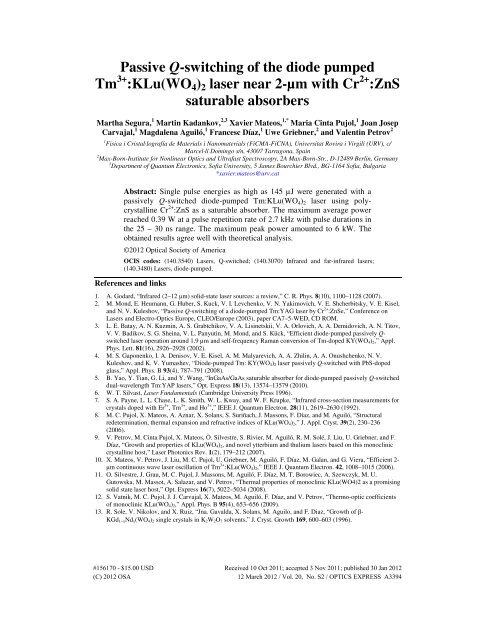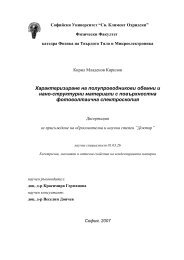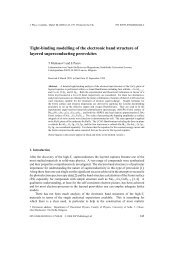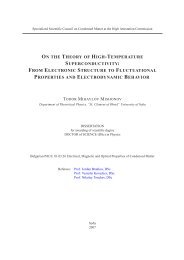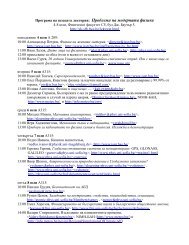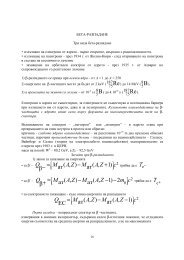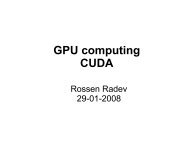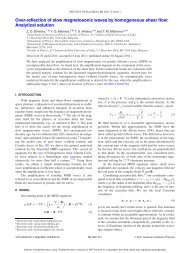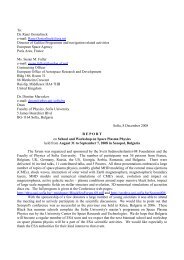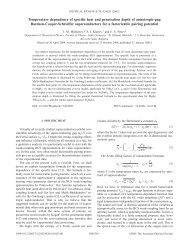Passive Q-switching of the diode pumped Tm :KLu(WO4)2 laser ...
Passive Q-switching of the diode pumped Tm :KLu(WO4)2 laser ...
Passive Q-switching of the diode pumped Tm :KLu(WO4)2 laser ...
You also want an ePaper? Increase the reach of your titles
YUMPU automatically turns print PDFs into web optimized ePapers that Google loves.
<strong>Passive</strong> Q-<strong>switching</strong> <strong>of</strong> <strong>the</strong> <strong>diode</strong> <strong>pumped</strong><br />
<strong>Tm</strong> 3+ :<strong>KLu</strong>(WO 4 ) 2 <strong>laser</strong> near 2-µm with Cr 2+ :ZnS<br />
saturable absorbers<br />
Martha Segura, 1 Martin Kadankov, 2,3 Xavier Mateos, 1,* Maria Cinta Pujol, 1 Joan Josep<br />
Carvajal, 1 Magdalena Aguiló, 1 Francesc Díaz, 1 Uwe Griebner, 2 and Valentin Petrov 2<br />
1 Fisica i Cristal·lografía de Materials i Nanomaterials (FiCMA-FiCNA), Universitat Rovira i Virgili (URV), c/<br />
Marcel·lí Domingo s/n, 43007 Tarragona, Spain<br />
2 Max-Born-Institute for Nonlinear Optics and Ultrafast Spectroscopy, 2A Max-Born-Str., D-12489 Berlin, Germany<br />
3 Department <strong>of</strong> Quantum Electronics, S<strong>of</strong>ia University, 5 James Bourchier Blvd., BG-1164 S<strong>of</strong>ia, Bulgaria<br />
*xavier.mateos@urv.cat<br />
Abstract: Single pulse energies as high as 145 µJ were generated with a<br />
passively Q-switched <strong>diode</strong>-<strong>pumped</strong> <strong>Tm</strong>:<strong>KLu</strong>(WO 4 ) 2 <strong>laser</strong> using polycrystalline<br />
Cr 2+ :ZnS as a saturable absorber. The maximum average power<br />
reached 0.39 W at a pulse repetition rate <strong>of</strong> 2.7 kHz with pulse durations in<br />
<strong>the</strong> 25 – 30 ns range. The maximum peak power amounted to 6 kW. The<br />
obtained results agree well with <strong>the</strong>oretical analysis.<br />
©2012 Optical Society <strong>of</strong> America<br />
OCIS codes: (140.3540) Lasers, Q-switched; (140.3070) Infrared and far-infrared <strong>laser</strong>s;<br />
(140.3480) Lasers, <strong>diode</strong>-<strong>pumped</strong>.<br />
References and links<br />
1. A. Godard, “Infrared (2–12 µm) solid-state <strong>laser</strong> sources: a review,” C. R. Phys. 8(10), 1100–1128 (2007).<br />
2. M. Mond, E. Heumann, G. Huber, S. Kuck, V. I. Levchenko, V. N. Yakimovich, V. E. Shcherbitsky, V. E. Kisel,<br />
and N. V. Kuleshov, “<strong>Passive</strong> Q-<strong>switching</strong> <strong>of</strong> a <strong>diode</strong>-<strong>pumped</strong> <strong>Tm</strong>:YAG <strong>laser</strong> by Cr 2+ :ZnSe,” Conference on<br />
Lasers and Electro-Optics Europe, CLEO/Europe (2003), paper CA7–5-WED, CD ROM.<br />
3. L. E. Batay, A. N. Kuzmin, A. S. Grabtchikov, V. A. Lisinetskii, V. A. Orlovich, A. A. Demidovich, A. N. Titov,<br />
V. V. Badikov, S. G. Sheina, V. L. Panyutin, M. Mond, and S. Kück, “Efficient <strong>diode</strong>-<strong>pumped</strong> passively Q-<br />
switched <strong>laser</strong> operation around 1.9 µm and self-frequency Raman conversion <strong>of</strong> <strong>Tm</strong>-doped KY(WO 4) 2,” Appl.<br />
Phys. Lett. 81(16), 2926–2928 (2002).<br />
4. M. S. Gaponenko, I. A. Denisov, V. E. Kisel, A. M. Malyarevich, A. A. Zhilin, A. A. Onushchenko, N. V.<br />
Kuleshov, and K. V. Yumashev, “Diode-<strong>pumped</strong> <strong>Tm</strong>: KY(WO 4) 2 <strong>laser</strong> passively Q-switched with PbS-doped<br />
glass,” Appl. Phys. B 93(4), 787–791 (2008).<br />
5. B. Yao, Y. Tian, G. Li, and Y. Wang, “InGaAs/GaAs saturable absorber for <strong>diode</strong>-<strong>pumped</strong> passively Q-switched<br />
dual-wavelength <strong>Tm</strong>:YAP <strong>laser</strong>s,” Opt. Express 18(13), 13574–13579 (2010).<br />
6. W. T. Silvast, Laser Fundamentals (Cambridge University Press 1996).<br />
7. S. A. Payne, L. L. Chase, L. K. Smith, W. L. Kway, and W. F. Krupke, “Infrared cross-section measurements for<br />
crystals doped with Er 3+ , <strong>Tm</strong> 3+ , and Ho 3+ ,” IEEE J. Quantum Electron. 28(11), 2619–2630 (1992).<br />
8. M. C. Pujol, X. Mateos, A. Aznar, X. Solans, S. Suriñach, J. Massons, F. Díaz, and M. Aguiló, “Structural<br />
redetermination, <strong>the</strong>rmal expansion and refractive indices <strong>of</strong> <strong>KLu</strong>(WO 4) 2,” J. Appl. Cryst. 39(2), 230–236<br />
(2006).<br />
9. V. Petrov, M. Cinta Pujol, X. Mateos, Ò. Silvestre, S. Rivier, M. Aguiló, R. M. Solé, J. Liu, U. Griebner, and F.<br />
Díaz, “Growth and properties <strong>of</strong> <strong>KLu</strong>(WO 4) 2, and novel ytterbium and thulium <strong>laser</strong>s based on this monoclinic<br />
crystalline host,” Laser Photonics Rev. 1(2), 179–212 (2007).<br />
10. X. Mateos, V. Petrov, J. Liu, M. C. Pujol, U. Griebner, M. Aguiló, F. Díaz, M. Galan, and G. Viera, “Efficient 2-<br />
µm continuous wave <strong>laser</strong> oscillation <strong>of</strong> <strong>Tm</strong> 3+ :<strong>KLu</strong>(WO 4) 2,” IEEE J. Quantum Electron. 42, 1008–1015 (2006).<br />
11. O. Silvestre, J. Grau, M. C. Pujol, J. Massons, M. Aguiló, F. Díaz, M. T. Borowiec, A. Szewczyk, M. U.<br />
Gutowska, M. Massot, A. Salazar, and V. Petrov, “Thermal properties <strong>of</strong> monoclinic <strong>KLu</strong>(<strong>WO4</strong>)2 as a promising<br />
solid state <strong>laser</strong> host,” Opt. Express 16(7), 5022–5034 (2008).<br />
12. S. Vatnik, M. C. Pujol, J. J. Carvajal, X. Mateos, M. Aguiló, F. Díaz, and V. Petrov, “Thermo-optic coefficients<br />
<strong>of</strong> monoclinic <strong>KLu</strong>(WO 4) 2,” Appl. Phys. B 95(4), 653–656 (2009).<br />
13. R. Sole, V. Nikolov, and X. Ruiz, “Jna. Gavalda, X. Solans, M. Aguilo, and F. Diaz, “Growth <strong>of</strong> β-<br />
KGd 1−xNd x(WO 4) 2 single crystals in K 2W 2O 7 solvents,” J. Cryst. Growth 169, 600–603 (1996).<br />
#156170 - $15.00 USD Received 10 Oct 2011; accepted 3 Nov 2011; published 30 Jan 2012<br />
(C) 2012 OSA<br />
12 March 2012 / Vol. 20, No. S2 / OPTICS EXPRESS A3394
14. M. Segura, X. Mateos, M. C. Pujol, J. J. Carvajal, M. Aguiló, F. Díaz, V. Panyutin, U. Griebner, and V. Petrov,<br />
“Diode-<strong>pumped</strong> passively Q-switched <strong>Tm</strong>:<strong>KLu</strong>W <strong>laser</strong> with a Cr 2+ :ZnSe saturable absorber,” Advanced Solid<br />
State Photonics, ASSP 2010, paper ATuA6, CD ROM.<br />
15. W. Koechner, Solid State Laser Engineering (Springer, 2006).<br />
1. Introduction<br />
The eye-safe <strong>laser</strong> emission region around 2 µm covered by <strong>Tm</strong> 3+ , Ho 3+ and codoped (<strong>Tm</strong> 3+ -<br />
Ho 3+ ) active media is important for medical applications, mainly due to <strong>the</strong> strong optical<br />
absorption by water, and remote sensing (LIDAR) <strong>of</strong> CO 2 and water in <strong>the</strong> atmosphere, as<br />
well as for pumping Optical Parametric Oscillators (OPO’s) for conversion into <strong>the</strong> mid-IR<br />
[1]. The <strong>Tm</strong> ion, emitting on <strong>the</strong> 3 F 4 → 3 H 6 transition, is attractive because its absorption band<br />
around 800 nm matches <strong>the</strong> emission <strong>of</strong> AlGaAs <strong>laser</strong> <strong>diode</strong>s designed for Nd 3+ -ion pumping.<br />
<strong>Passive</strong> Q-<strong>switching</strong> (PQS) <strong>of</strong> such <strong>diode</strong>-<strong>pumped</strong> solid state <strong>laser</strong>s (DPSSL) by a saturable<br />
absorber (SA) is a common technique to generate short and high peak power pulses, mainly<br />
due to <strong>the</strong> simplicity and low cost <strong>of</strong> <strong>the</strong> cavity design. It has been applied to several <strong>Tm</strong>doped<br />
<strong>laser</strong> materials such as YAG [2], KY(WO 4 ) 2 [3,4], and YAP [5] using Cr 2+ :ZnSe and<br />
Cr 2+ :ZnS crystals, PbS quantum dots, and InGaAs/GaAs semiconductor based SAs.<br />
Concerning <strong>the</strong> monoclinic double tungstates, PQS around 1.9 µm with Cr 2+ :ZnS and<br />
Cr 2+ :ZnSe SAs was demonstrated using <strong>Tm</strong> 3+ :KY(WO 4 ) 2 and codoped Yb 3+ ,<strong>Tm</strong> 3+ :KY(WO 4 ) 2<br />
[3]. The best result <strong>of</strong> 116 mW output power at a repetition rate <strong>of</strong> 20 kHz with Yb 3+ ,<strong>Tm</strong> 3+ :<br />
KY(WO 4 ) 2 and Cr 2+ :ZnS corresponds to a single pulse energy <strong>of</strong> 6.7 µJ and a pulse duration<br />
<strong>of</strong> 63 ns. Note that such high repetition rates do not allow one to fully utilize <strong>the</strong> long storage<br />
time <strong>of</strong> <strong>Tm</strong> which intrinsically limits <strong>the</strong> pulse energy. More recently, PQS <strong>of</strong> <strong>Tm</strong> 3+ :<br />
KY(WO 4 ) 2 has been achieved also using PbS-doped glass as SA [4]. In this set-up, up to 44<br />
µJ <strong>of</strong> single pulse energy was produced at a repetition rate <strong>of</strong> 2.5 kHz but for <strong>the</strong> pulse<br />
duration only an upper detection limit <strong>of</strong> 60 ns was given.<br />
Concerning o<strong>the</strong>r <strong>Tm</strong> 3+ -doped crystals, semiconductor based SAs have been used for PQS<br />
<strong>of</strong> a <strong>Tm</strong> 3+ :YAP <strong>laser</strong> in [5] achieving a maximum pulse energy <strong>of</strong> 28.1 µJ at a repetition rate<br />
<strong>of</strong> 43.7 kHz, however, <strong>the</strong> pulse duration, 447 ns, was ra<strong>the</strong>r long. The highest pulse energy<br />
(~400 µJ) from a <strong>diode</strong>-<strong>pumped</strong> PQS <strong>laser</strong>, to <strong>the</strong> best <strong>of</strong> our knowledge, has been achieved in<br />
<strong>Tm</strong> 3+ :YAG using Cr 2+ :ZnSe as SA [2]: However, <strong>the</strong> pulse duration in this <strong>laser</strong> was also<br />
untypically long for PQS (about 300 ns), resulting in a peak power <strong>of</strong> about 1 kW.<br />
A good choice <strong>of</strong> SA for PQS must fulfil <strong>the</strong> relation I SA σ SA >I g σ 0 [6] where I SA is <strong>the</strong> <strong>laser</strong><br />
intensity in <strong>the</strong> SA, σ SA is <strong>the</strong> absorption cross-section <strong>of</strong> <strong>the</strong> SA at <strong>the</strong> <strong>laser</strong> wavelength, I g is<br />
<strong>the</strong> intensity <strong>of</strong> <strong>the</strong> <strong>laser</strong> beam in <strong>the</strong> gain medium and σ 0 is <strong>the</strong> stimulated emission crosssection<br />
<strong>of</strong> <strong>the</strong> gain medium. Also <strong>the</strong> SA must have a short upper level lifetime compared to<br />
that <strong>of</strong> <strong>the</strong> gain medium. Long gain upper lifetimes ensure high energy storage and<br />
consequently high energy output pulses. For instance, <strong>the</strong> upper lifetime <strong>of</strong> <strong>Tm</strong>:YAG (~10 ms<br />
[7]) is few times longer than in monoclinic double tungstates (see Table 1).<br />
In this paper, we report on PQS <strong>of</strong> a DPSSL based on <strong>the</strong> monoclinic potassium lutetium<br />
tungstate <strong>KLu</strong>(WO 4 ) 2 , doped with 3 at.% <strong>Tm</strong> 3+ , hereafter <strong>Tm</strong>:<strong>KLu</strong>W. In <strong>the</strong>se biaxial crystals,<br />
three principal optical axes exist associated with <strong>the</strong> three refractive indices, n p
Table 1. Properties <strong>of</strong> <strong>Tm</strong>:<strong>KLu</strong>W (* undoped crystal).<br />
Doping level (solution)<br />
3 at.% <strong>Tm</strong><br />
Ion concentration 2 × 10 20 at/cm 3<br />
Pump wavelength, λ p [10]<br />
802 nm, E//N m<br />
Absorption cross section, σ a [10]<br />
5.95 × 10 −20 cm 2 for E//N m<br />
Absorption linewidth [10]<br />
4 nm, E//N m<br />
Stimulated emission cross section, σ 0 (1920 nm) [10] 1.38 × 10 −20 cm 2<br />
2. Experimental setup<br />
3 F 4 fluorescence lifetime, τ a [10] 1.34 ms<br />
Saturation intensity (I = hc/σ aτ aλ p) 3.1 kW/cm 2<br />
Thermal expansion coefficient (10 −6 K −1 )* [11] α p = 3.35, α m = 11.19, α g = 14.55<br />
Thermal conductivity at 300 K (W/m K)* [11] κ p = 2.36, κ m = 3.41, κ g = 3.59<br />
dn p/dT, dn m/dT, dn g/dT (10 −6 K −1 )* [12] −10.8, −1.6, −7.4<br />
Refractive indices at 1946 nm* [8] n p = 1.96, n m = 2.01, n g = 2.06<br />
High optical quality <strong>Tm</strong>:<strong>KLu</strong>W crystals were grown by <strong>the</strong> Top Seeded Solution Growth<br />
Slow Cooling (TSSG-SC) method, according to <strong>the</strong> procedure described in [13]. For <strong>the</strong> <strong>laser</strong><br />
experiments, we constructed an L-shape hemispherical resonator depicted in Fig. 1. The pump<br />
was delivered through <strong>the</strong> plane mirror (M1), antireflection (AR) coated for <strong>the</strong> pump<br />
wavelength (802 nm) and high reflection (HR) coated for <strong>the</strong> <strong>laser</strong> wavelength (1900-2400<br />
nm). As output coupler (M3) we tested mirrors with transmission T oc = 5% and 10% (1820-<br />
2050 nm) and radius <strong>of</strong> curvature R oc = −75 mm. The bending mirror (M2) was plane, AR s-<br />
pol, p-pol (45°, 790-820 nm) and HR s-pol (45°, 1700-2280 nm) + HR p-pol (45°, 1790-2120 nm). The<br />
pump source was a fiber-coupled (NA = 0.22, 200 µm core diameter) AlGaAs <strong>diode</strong> <strong>laser</strong><br />
delivering up to 10 W at 802 nm (DILAS). The active elements were cut for propagation<br />
along <strong>the</strong> N g direction with dimensions 2 × 3 × 3 mm 3 along N p × N m × N g . The AR-coated<br />
samples (both for pump and <strong>laser</strong> wavelengths) were mounted in a Cu holder with circulating<br />
water at 16°C for heat dissipation. The incident pump beam was focused to a 200 µm spot<br />
diameter on <strong>the</strong> crystal with a lens assembly <strong>of</strong> 20 mm focal length. The polycrystalline<br />
Cr 2+ :ZnS SA samples (IPG Photonics), were specified with low signal transmission (corrected<br />
for Fresnel reflections) <strong>of</strong> T 0 = 78, 85 and 92% at 1910 nm. The AR-coating reduced <strong>the</strong><br />
reflection to about 1% per surface. The SAs were 2.2 mm thick, with lateral dimensions <strong>of</strong> 4.5<br />
× 9.3 mm 2 . The output pulses were detected with a fast InGaAs photo<strong>diode</strong> with
3. Results<br />
In our preliminary work on PQS <strong>of</strong> <strong>the</strong> <strong>Tm</strong>:<strong>KLu</strong>W <strong>laser</strong> in a linear cavity [14] we established<br />
that it is ra<strong>the</strong>r difficult to stabilize <strong>the</strong> pulse train, mainly due to <strong>the</strong> direct heating <strong>of</strong> <strong>the</strong> SA<br />
(in that case Cr 2+ :ZnSe with T 0 = 75% at 1950 nm) by <strong>the</strong> residual non-absorbed pump. Thus,<br />
<strong>the</strong> maximum pulse energy achieved with <strong>Tm</strong>:<strong>KLu</strong>W was 16 µJ. To improve this<br />
performance, we designed <strong>the</strong> 3 mirror L-shaped cavity described before, with a length <strong>of</strong> L 1<br />
+ L 2 = L c and L 1 = 30 mm, in which <strong>the</strong> folding mirror transmits <strong>the</strong> non-absorbed pump.<br />
In <strong>the</strong> present work we used polycrystalline Cr 2+ :ZnS samples as SA. It was not possible<br />
to obtain Q-<strong>switching</strong> with <strong>the</strong> Cr 2+ :ZnSe plates because <strong>the</strong> fluence was not high enough to<br />
bleach Cr 2+ :ZnSe at <strong>the</strong> longer distance between SA and pump mirror in <strong>the</strong> folded cavity.<br />
Additionally, <strong>the</strong> initial transmissions <strong>of</strong> Cr 2+ :ZnSe at 1910 nm were lower (50%, 76% and<br />
78%) compared to <strong>the</strong> applied Cr 2+ :ZnS samples. The estimated <strong>laser</strong> beam diameters were<br />
140 and 350 µm at <strong>the</strong> <strong>Tm</strong>:<strong>KLu</strong>W crystal and SA position (L SA = 40 mm), respectively. The<br />
absorption cross-section at 1920 nm <strong>of</strong> Cr 2+ :ZnS SA is 4 × 10 −19 cm 2 and <strong>the</strong> emission crosssection<br />
<strong>of</strong> <strong>the</strong> <strong>laser</strong> crystal at <strong>the</strong> same wavelength is 1.38 × 10 −20 cm 2 . Toge<strong>the</strong>r with <strong>the</strong> spot<br />
sizes <strong>of</strong> <strong>the</strong> <strong>laser</strong> beam at <strong>the</strong> <strong>laser</strong> crystal and <strong>the</strong> SA this gives I SA σ SA ~4.6 I g σ 0 that matches<br />
with <strong>the</strong> criteria exposed in <strong>the</strong> introduction.<br />
Average output power (W)<br />
1,5 T oc =10%, λ L =1917-1925 nm<br />
1,2<br />
0,9<br />
0,6<br />
0,3<br />
CW, η=21.3%<br />
T 0 =92%, η=16.9%<br />
T 0 =85%, η=5.7%<br />
T 0 =78%, η=6.2%<br />
0,0<br />
0 1 2 3 4 5 6 7 8<br />
Incident power (W)<br />
Fig. 2. CW and passively Q-switched power characteristics <strong>of</strong> <strong>the</strong> <strong>Tm</strong>:<strong>KLu</strong>W <strong>laser</strong> with T oc =<br />
10% and R oc = −75 mm output coupler and different SAs.<br />
Fig. 3. PQS characteristics <strong>of</strong> <strong>the</strong> <strong>Tm</strong>:<strong>KLu</strong>W <strong>laser</strong> with a) T oc = 10% for T 0 = 92%, 85% and<br />
78% Cr 2+ :ZnS SAs, and b) T oc = 5% for T 0 = 92%.<br />
The CW and PQS performance <strong>of</strong> <strong>the</strong> <strong>laser</strong> with <strong>Tm</strong>:<strong>KLu</strong>W crystal, naturally polarized<br />
along N m , is shown in Fig. 2 for T oc = 10%. In all cases <strong>the</strong> cavity length was decreased from<br />
74 mm in CW mode to 73 mm in PQS regime compensating <strong>the</strong> optical path in <strong>the</strong> SA<br />
#156170 - $15.00 USD Received 10 Oct 2011; accepted 3 Nov 2011; published 30 Jan 2012<br />
(C) 2012 OSA<br />
12 March 2012 / Vol. 20, No. S2 / OPTICS EXPRESS A3397
(n~2.27 at 1.9 µm). Figure 3a shows <strong>the</strong> average output power, repetition rate, pulse energy<br />
and pulse duration (FWHM) obtained in stable PQS regime using T oc = 10% and Fig. 3b <strong>the</strong><br />
same parameters with T oc = 5% for which only <strong>the</strong> T 0 = 92% SA ensured stable operation. For<br />
T oc = 10%, <strong>the</strong> SA with T 0 = 92% Q-switched <strong>the</strong> <strong>laser</strong> in almost any position in <strong>the</strong> second<br />
arm but <strong>the</strong> highest output power was obtained at <strong>the</strong> maximum possible separation from <strong>the</strong><br />
output coupler, L SA = 40 mm (350 µm spot size). For T oc = 5%, with <strong>the</strong> same SA most stable<br />
operation was achieved at L SA = 20 mm (400 µm spot size). The maximum average output<br />
power amounted to 0.39 W with T oc = 10% and 0.26 W with T oc = 5% at incident pump<br />
powers <strong>of</strong> 4.2 and 3.5 W, respectively, <strong>the</strong> limits set by SA bleaching. At <strong>the</strong> same pump<br />
levels, <strong>the</strong> output power in <strong>the</strong> CW regime (SA removed), was 0.66 and 0.75 W for T oc = 10%<br />
(Fig. 2) and 5% (not shown), respectively, which translates into CW to PQS conversion <strong>of</strong><br />
59% and 35%, respectively. The estimated small-signal absorption <strong>of</strong> <strong>the</strong> <strong>Tm</strong>:<strong>KLu</strong>W crystal<br />
was 70%, so that <strong>the</strong> net pump efficiency in <strong>the</strong> PQS regime was 13% and 11% for T oc = 10%<br />
and 5%, respectively.<br />
Fig. 4. Dependence <strong>of</strong> <strong>the</strong> pulse repetition rate (prr) and single pulse shapes on <strong>the</strong> pump level<br />
using T oc = 10% and Cr 2+ :ZnS SA with T 0 = 92%.<br />
The <strong>laser</strong> wavelength in PQS operation for T oc = 5% was λ L = 1918 nm with 2 nm<br />
bandwidth, while <strong>the</strong> <strong>laser</strong> emission for T oc = 10% was in <strong>the</strong> λ L = 1917-1925 nm range. The<br />
instabilities <strong>of</strong> <strong>the</strong> pulse train reduce with when <strong>the</strong> pumping power increased, e.g. from ±<br />
20% at P inc = 3.5 W (Fig. 4a) to ± 10% at P inc = 4.2 W (Fig. 4c) for T oc = 10%. The pulse<br />
shapes corresponding to <strong>the</strong>se cases are shown in Figs. 4b and 4d. With <strong>the</strong> T 0 = 92% SA, <strong>the</strong><br />
pulse duration was slightly shorter for T oc = 10% in comparison to T oc = 5%, decreasing<br />
typically from ~30 ns to ~24 ns. The shortest pulses (~10 ns) for T oc = 10% were obtained<br />
with <strong>the</strong> T 0 = 78% SA for a pulse energy <strong>of</strong> 50 µJ (Fig. 3a), <strong>the</strong> peak power is 5 kW.<br />
The repetition rate at maximum power with T oc = 5% was 2 kHz corresponding to a<br />
maximum single pulse energy <strong>of</strong> 127 µJ and maximum peak power <strong>of</strong> 4.4 kW. The maximum<br />
energy achieved with T oc = 10% was 145 µJ at a repetition rate <strong>of</strong> 2.7 kHz, with peak power<br />
<strong>of</strong> 6 kW. In fact this energy corresponded to saturation at incident pump powers ~4 W, with<br />
fur<strong>the</strong>r increase <strong>of</strong> <strong>the</strong> average output power only due to <strong>the</strong> increasing repetition rate (Fig. 3).<br />
The quality <strong>of</strong> <strong>the</strong> beam, determined by <strong>the</strong> knife-edge method, was M x 2 = M y 2 = 1.2.<br />
#156170 - $15.00 USD Received 10 Oct 2011; accepted 3 Nov 2011; published 30 Jan 2012<br />
(C) 2012 OSA<br />
12 March 2012 / Vol. 20, No. S2 / OPTICS EXPRESS A3398
4. Theoretical analysis <strong>of</strong> <strong>the</strong> passively Q-switched <strong>Tm</strong>:<strong>KLu</strong>W <strong>laser</strong> performance<br />
The optimal PQS parameters can be calculated following an analytical approach [15]. They<br />
can be expressed in terms <strong>of</strong> a single variable z = 2g 0 l/δ, where 2g 0 l is <strong>the</strong> small-signal gain<br />
and δ is <strong>the</strong> round-trip loss due to diffraction, scattering and absorption. To determine <strong>the</strong>se<br />
two, it is possible to apply <strong>the</strong> Findlay-Clay method [15] assuming good <strong>the</strong>rmal management<br />
and minimum reabsorption losses so that <strong>Tm</strong>:<strong>KLu</strong>W can be considered as quasi-three level<br />
<strong>laser</strong>. This method uses <strong>the</strong> relationship between loss and threshold gain, so that <strong>the</strong> pump<br />
power at <strong>the</strong> <strong>laser</strong> threshold is expressed in terms <strong>of</strong> <strong>the</strong> reflectance <strong>of</strong> output coupler R = 1-<br />
T oc :<br />
2η<br />
exc<br />
− ln R = Pp<br />
− δ = 2 g0l<br />
− δ.<br />
(1)<br />
A I<br />
p<br />
s<br />
where η exc is <strong>the</strong> excitation efficiency, A p is <strong>the</strong> area <strong>of</strong> <strong>the</strong> pump beam in <strong>the</strong> crystal and I s is<br />
<strong>the</strong> saturation intensity. Using mirrors with T oc = 1.5, 3, 5, 9 and 15% in CW operation <strong>the</strong><br />
loss per round trip obtained is 9%, and <strong>the</strong> small-signal gain is 0.204 P p , in this way, <strong>the</strong><br />
parameter z is determined and depends only on P p . The output energy is <strong>the</strong>n given by<br />
Ahνδ<br />
E<br />
p<br />
= ( z −1− ln z).<br />
(2)<br />
2σ γ<br />
0<br />
where A is <strong>the</strong> area <strong>of</strong> <strong>the</strong> <strong>laser</strong> beam (70 µm radius), hν is <strong>the</strong> photon energy and γ is one for<br />
four-level <strong>laser</strong>s or two for three-level <strong>laser</strong>s. Finally, <strong>the</strong> pulse duration is also determined by<br />
2Lc<br />
⎛ ln z ⎞<br />
∆ t =<br />
cδ<br />
⎜<br />
z[1 − a(1 − ln a)]<br />
⎟<br />
⎝<br />
⎠<br />
(3)<br />
with a = ( z − 1) / ( z ln z)<br />
. The calculated optimum parameters for <strong>the</strong> <strong>Tm</strong>:<strong>KLu</strong>W <strong>laser</strong> are<br />
shown in Fig. 5 toge<strong>the</strong>r with <strong>the</strong> experimental results obtained with T oc = 10% and T 0 = 92%,<br />
85% and 78%. There is a good agreement in <strong>the</strong> pulse energy for incident power in <strong>the</strong> 2.2 –<br />
3.4 W range (T 0 = 92%), at higher powers saturation is experimentally observed, not taken<br />
into account in <strong>the</strong> model. The <strong>the</strong>ory predicts well also <strong>the</strong> pulse durations for T 0 = 85% and<br />
78%.<br />
5. Conclusion<br />
Fig. 5. Experimental results compared with a) calculated pulse energy and b) pulse duration,<br />
depending on <strong>the</strong> incident power for <strong>the</strong> <strong>Tm</strong>:<strong>KLu</strong>W crystal and T oc = 10%.<br />
We have achieved passive Q-<strong>switching</strong> operation <strong>of</strong> a <strong>diode</strong>-<strong>pumped</strong> <strong>Tm</strong>:<strong>KLu</strong>W <strong>laser</strong><br />
emitting near 1920 nm using polycrystalline Cr 2+ :ZnS samples as saturable absorbers. The<br />
best results without optical damage were obtained with T oc = 10% and T 0 = 92% for 3 at.%<br />
<strong>Tm</strong> doping in terms <strong>of</strong> maximum energy <strong>of</strong> 145 µJ, pulse durations in <strong>the</strong> 24 – 30 ns range,<br />
#156170 - $15.00 USD Received 10 Oct 2011; accepted 3 Nov 2011; published 30 Jan 2012<br />
(C) 2012 OSA<br />
12 March 2012 / Vol. 20, No. S2 / OPTICS EXPRESS A3399
epetition rate around 2.7 kHz and 0.39 W <strong>of</strong> average output power. In comparison with [3],<br />
based on similar <strong>laser</strong> crystal and SA, <strong>the</strong> improvement achieved is by a factor >3 in <strong>the</strong><br />
average power, >20 in <strong>the</strong> pulse energy and >50 in <strong>the</strong> peak power. In fact, with <strong>the</strong> present<br />
setup, average output powers <strong>of</strong> 0.6 W and pulse energies <strong>of</strong> 200 µJ could be reached at<br />
incident pump power <strong>of</strong> 7 W for T 0 = 92% and T oc = 10% at 3 kHz. However, at such high<br />
intracavity fluence we observed SA damage within minutes, even in positions close to <strong>the</strong><br />
output coupler. Fur<strong>the</strong>r improvement <strong>of</strong> <strong>the</strong> present results can be expected for SAs with<br />
T 0 >92%. We conclude that polycrystalline Cr 2+ :ZnS is superior as SA at wavelengths around<br />
2 µm in comparison with PbS quantum dots-doped glass [4] or semiconductor SAs [5] for<br />
PQS <strong>of</strong> <strong>diode</strong>-<strong>pumped</strong> <strong>Tm</strong>-<strong>laser</strong>s.<br />
Acknowledgments<br />
This work was supported by <strong>the</strong> Spanish Government under projects MAT c2008-06729-C02-<br />
02/NAN, MAT2010-11402-E, DE2009-0002 and PI09/90527, and <strong>the</strong> Catalan Government<br />
under project 2009SGR235 and <strong>the</strong> fellowship 2011FI_B2 00013 (M. Segura). We also<br />
acknowledge support from <strong>the</strong> ECs 7th Framework Programme under project Cleanspace,<br />
FP7-SPACE-2010-1-GA-263044, LASERLAB-EUROPE, grant agreement No. 228334 and<br />
<strong>the</strong> German-Spanish bilateral Programme Acciones Integradas (ID 50279160).<br />
#156170 - $15.00 USD Received 10 Oct 2011; accepted 3 Nov 2011; published 30 Jan 2012<br />
(C) 2012 OSA<br />
12 March 2012 / Vol. 20, No. S2 / OPTICS EXPRESS A3400


